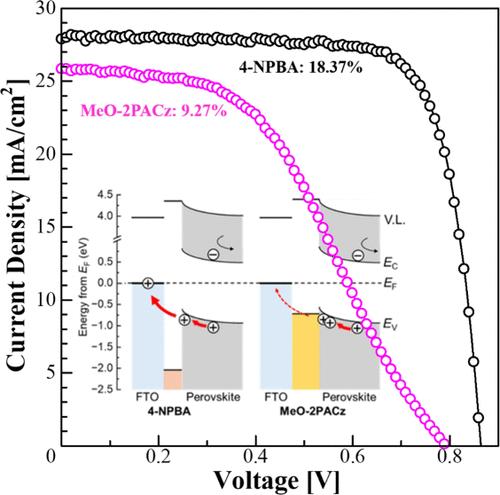理想带隙倒置锡铅钙钛矿太阳能电池中基于硼酸自组装单层的界面偶极子工程
IF 18.2
1区 材料科学
Q1 CHEMISTRY, PHYSICAL
引用次数: 0
摘要
根据单结太阳能电池的详细平衡极限,具有1.4 eV带隙的钙钛矿理论上可以实现33%以上的功率转换效率(pce),但其进展受到PEDOT:PSS的吸湿性以及与MeO-2PACz等自组装单层(sam)的不兼容性的限制。采用硼酸(BA)基sam,特别是4-硝基苯基硼酸(4-NPBA),其PCE显著提高(18.37%)。这是由于ba基sam的大分子偶极矩显著增加了FTO的功函数(WF),在钙钛矿层中诱导了更强的能带弯曲。这种能带弯曲的大小与SAM和钙钛矿之间的WF差成正比,有助于更有效地收集空穴。相比之下,基于meo - 2pacz的器件收率仅为9.27%,且呈现s型电流-电压(I-V)曲线,这主要是由于形成了界面能垒。此外,即使具有界面能垒,ba基SAMs的优越性能也可以通过以下方式来解释:(i)密度泛函数理论(DFT)计算出的ba基SAMs分子长度较短,有助于隧道效应的增强;或(ii) x射线光电子能谱(XPS)的吸收密度估计证明,由于表面覆盖率较低,钙钛矿通过未覆盖的FTO区域直接将空穴从钙钛矿转移到FTO。瞬态吸收(TA)和瞬态光电流衰减(TPC)分析进一步支持了上述研究结果。结果表明,当4-NPBA用作SAM层时,空穴萃取率(3.73 × 10-3 ps-1)显著提高,电荷输运时间(1.18 μs)显著降低。本文章由计算机程序翻译,如有差异,请以英文原文为准。

Interfacial Dipole Engineering via Boronic Acid-Based Self-Assembled Monolayers in Inverted Tin–Lead Perovskite Solar Cells with Ideal Band Gap
According to the detailed balance limit for a single-junction solar cell, perovskites with a 1.4 eV band gap can theoretically achieve power conversion efficiencies (PCEs) above 33%, but their progress is limited by the hygroscopic nature of PEDOT:PSS and incompatibility with self-assembled monolayers (SAMs) like MeO-2PACz. Using boronic acid (BA)-based SAMs, especially 4-nitrophenyl boronic acid (4-NPBA), the PCE was greatly improved (18.37%). This is attributed to the large molecular dipole moments of the BA-based SAMs significantly increasing the work function (WF) of the FTO, inducing stronger band bending in the perovskite layer. This band bending, whose magnitude is proportional to the difference in the WF between the SAM and the perovskite, facilitated more efficient hole collection. In comparison, MeO-2PACz-based devices yielded only 9.27% and showed an S-shaped current–voltage (I–V) curve, mainly due to the formation of an interfacial energy barrier. Furthermore, the superior performance of the BA-based SAMs even after possessing an interfacial energy barrier can be explained by enhanced hole collection via (i) tunneling aided by short molecular length of BA-based SAMs as calculated by density functional theory (DFT), or (ii) direct hole transfer from perovskite to FTO through the uncovered FTO regions due to lower surface coverage as evidenced by absorption density estimation in X-ray photoelectron spectroscopy (XPS). These findings were further supported by transient absorption (TA) as well as transient photocurrent decay (TPC) analyses, which revealed markedly higher hole extraction rate (3.73 × 10–3 ps–1) and lower charge transport time (1.18 μs) when 4-NPBA was used as a SAM layer.
求助全文
通过发布文献求助,成功后即可免费获取论文全文。
去求助
来源期刊

ACS Energy Letters
Energy-Renewable Energy, Sustainability and the Environment
CiteScore
31.20
自引率
5.00%
发文量
469
审稿时长
1 months
期刊介绍:
ACS Energy Letters is a monthly journal that publishes papers reporting new scientific advances in energy research. The journal focuses on topics that are of interest to scientists working in the fundamental and applied sciences. Rapid publication is a central criterion for acceptance, and the journal is known for its quick publication times, with an average of 4-6 weeks from submission to web publication in As Soon As Publishable format.
ACS Energy Letters is ranked as the number one journal in the Web of Science Electrochemistry category. It also ranks within the top 10 journals for Physical Chemistry, Energy & Fuels, and Nanoscience & Nanotechnology.
The journal offers several types of articles, including Letters, Energy Express, Perspectives, Reviews, Editorials, Viewpoints and Energy Focus. Additionally, authors have the option to submit videos that summarize or support the information presented in a Perspective or Review article, which can be highlighted on the journal's website. ACS Energy Letters is abstracted and indexed in Chemical Abstracts Service/SciFinder, EBSCO-summon, PubMed, Web of Science, Scopus and Portico.
 求助内容:
求助内容: 应助结果提醒方式:
应助结果提醒方式:


